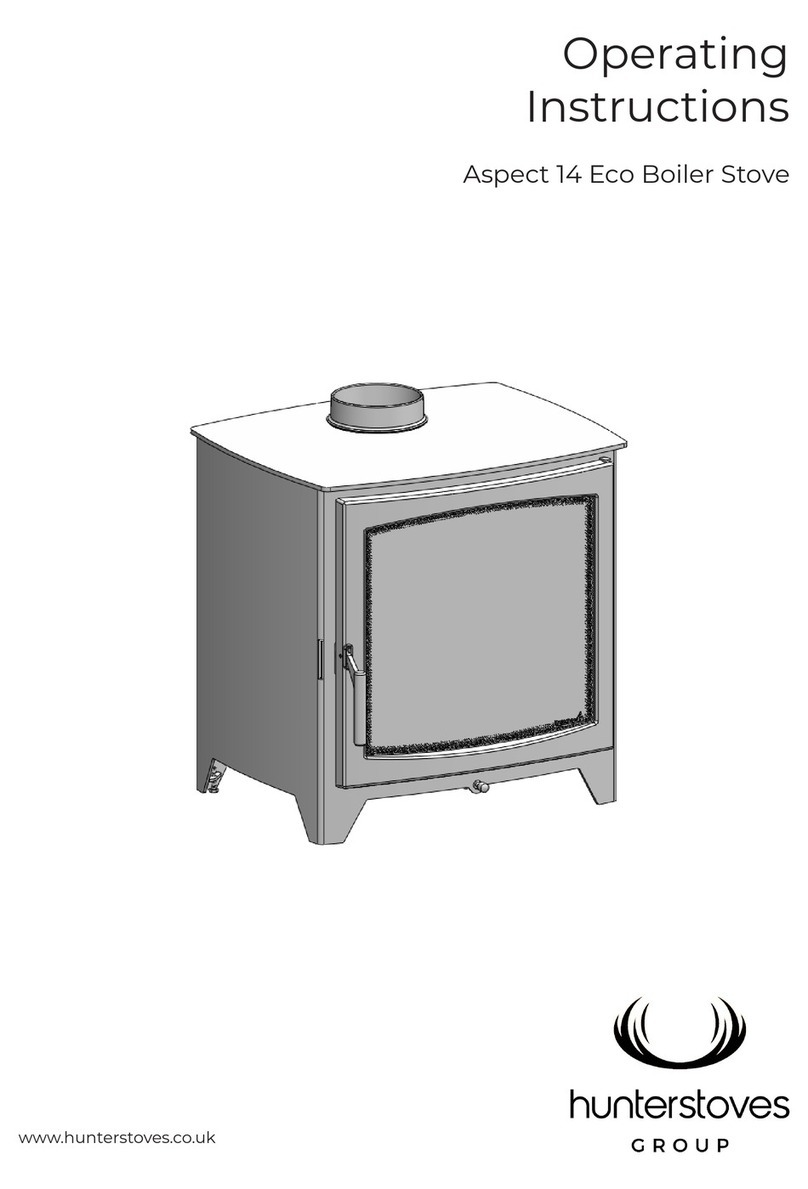10
The stove can be recessed in a suitable sized
fireplace but must have a permanent free air gap of
at least 15 mm on top and 5 mm (although we
recommend 15 mm) around the sides and 5 mm at
the back of the stove to obtain maximum heat
output and for access to the rear of the stove.
The hearth should extend at least 3 mm from the
front of the stove. The stove should stand wholly
above a solid, non-combustible hearth, at least 125
mm thick (this may include the thickness of a solid
floor or a non-combustible decorative hearth.
If the stove is not to stand in a recess, it may stand
wholly above a hearth made of non-combustible
board / sheet material or tiles, at least 12mm thick.
The hearth should extend at least 15 mm from the
sides and rear of the stove, and at least 3 mm
from the front of the stove (35 mm
recommended).
INSTALLATION OF BOILER
MODELS
We strongly recommend that a knowledgeable,
experienced and qualified plumbing and heating
engineer is responsible for the design and
installation of the heating and hot water system.
Hunter Stoves Group cannot accept responsibility
for any consequential loss, however caused, due to
under or over specification of the appliance in any
installation.
Do Not – Under any circumstances connect the
stove to a sealed (pressurised)heating system or
unvented hot water cylinder.
Do Not – Link the stove into a heating or hot water
system with an existing boiler without the use
of suitable equipment such as a neutraliser. When
fitting this type of system, the neutraliser
manufacturer’s instructions must be followed.
Do – Fit an open cold feed and expansion cistern
with separate cold feed and vent pipes. The cold
feed and vent pipes must be unvalved. The open
vent pipe should have a diameter of 22mm and rise
continuously from the boiler. It is common practice
to form the vent pipe from an extension of the
primary flow (see diagram).
Do – Connect the stove to a double eed, indirect
hot water cylinder via 28mm copper flow and
return pipework, rising continuously from the boiler
to the cylinder. The cylinder and heat leak radiator
must be sited higher than the stove.
Semi pumped systems should be used on heating
and hot water systems with gravity circulation to
the hot water cylinder and one unvalved 2 KW
radiator to act as a heat leak when the central
heating is switched off.
All four tappings on wraparound boilers should be
used for systems incorporating separate gravity and
pumped heating loops. Each flow and return should
be taken from diagonally opposite sides of the
boiler.
If a common flow and return is used, these should
also be taken from diagonally opposite sides of a
wraparound boiler, and plugs inserted into the
sockets not used.
Systems using a common flow and return to the
boiler should incorporate an injector tee on the
primary return connection from the central heating
pump (see diagram).
A HIGH LIMIT thermostat should be fitted to the
gravity flow pipe close to the boiler and set at
9 °C. This should override any pump control,
switching the pump on and dissipating any excess
heat around the radiator circuit.
To prevent boiler corrosion due to condensation it
is necessary to maintain the return water
temperature above 45°C. This can be achieved by
the use of a LOW LIMIT thermostat on the return
pipe from the hot water cylinder, close to the
boiler. The thermostat should make on temperature
rise, preventing the circulating pump from
operating until the gravity circuit is up to
temperature.
A corrosion inhibitor should be added to the system
to ensure satisfactory performance and long
system life.
Wiring Diagram for general guidance only
All electrical work must be carried out by a competent
electrician in accordance with the rules in force and the
instructions provided by the circulating pump and heating
controls manufacturer





























